Journal of Psychology & Psychotherapy
Open Access
ISSN: 2161-0487
ISSN: 2161-0487
Research Article - (2019)Volume 9, Issue 2
Producing a qualified medical doctor is a herculean task by the health care institution and that it solely based on one’s personality trait assessing which it facilitates to groom a freshly entering medical student into a qualified medical graduate. Screening their personality trait will help in grooming the person to plan for counseling sessions according to the need and that it will help to facilitate their learning styles to become a qualified doctor. I year medical students were screened for their personality traits and based on the scores obtained by them the students were categorized and counselled as and when required. The percentile scores obtained by the students revealed their level of personality and the weaker areas which are in need of counseling to overcome their negative personality. The results obtained from the scale revealed most of the students fall under different scores under the five big personality traits – Extroversion, Emotional stability, Agreeableness, Conscientiousness, and Intellect/Imagination. Percentile scores obtained by the students were tabulated and discussed.
Medical students; Personality; Screening; Counseling
Medical Education in India is reported to be declining in its quality since 1990 as a result of which a number of medical education activities have been initiated by Medical council of India in the forms of revising the curriculum, implementing new medical education technology programs, workshops to improve quality of medical teachers etc., Though many educationists and educational psychologists concentrate on how to improve the quality of education, they fail to assess and contribute to the psychological status of the individual who enter into this medical stream with varied background. The psychological background of an individual plays a major role in grooming himself or herself into a qualified doctor who is going to be health care taker of the society. Students entering the medical profession in India hail from different culture, societal status, educational level, emotional status etc. Once they enter the medical school, due to their difference in various psychological levels, many a times they find it very difficult to acquaint to the new study atmosphere. The present work mainly focused on screening the personality traits of an individual at the entry level of a medical school. Based on the screened results, counseling sessions were planned to the low scored individuals to groom them to get accustom into the new study atmosphere.
First year medical students joined in a private medical college situated in Tamil Nadu, India was selected for the study. Online Goldberg scale with 50-item questionnaire for screening the personality trait was used for the study. Prior permission was obtained from Dr. GoldbergR for using the scale for educational non-profitable purpose. Universal Permission was granted by the owner (GoldbergR) of the Personality Scale which is available free of access for the users. 100 first year medical students studying in a private medical college were selected for the study [1].
Ethical clearance was obtained from Institutional Ethical Committee. Students were first sensitized about the study. Formal consent was taken from the participants prior to administration of questionnaire. Online questionnaire was administered on the 4th day of the orientation program. During the session, Goldberg link was shared with the students and were asked to fill the questionnaire. Students were gathered on one weekend and were given with the link to complete the survey. Thirty minutes was given to them to respond to the questionnaire. The result page was collected through mail. Documents were preserved confidentially. Results were tabulated, analyzed and discussed. Raw scores obtained by the students were compared with the percentile scores of the Goldberg’s scale and the students' personality traits’ were discussed.
Goldberg personality test questionnaire is a globally accepted standardized and a validated scale to assess and evaluate personality of an individual. This questionnaire was prepared based on five personality traits, which are referred to as basic traits of an individual to assess their personality towards academic performance. These items are called as International Personality Item Pool (IPIP) scales. This was initiated by Hofstee, Wim K and his team at the University of Groningen in Netherlands in 1997. After this, a scientist called Goldberg developed a single scale with 50 items to assess the basic personality traits of an individual to understand their academic personality whether suitable for the particular stream of studies. This scale is an easiest one and shall be used as a first step to assess the personality of an individual. This scale is widely used globally in all case studies and research activities.
The big five personality traits are the best accepted and most commonly used model of personality in academic psychology. The big five come from the statistical study of responses to personality items. Using a technique called factor analysis researchers can look at the responses of people to hundreds of personality items and ask the question "what is the best was to summarize an individual?” This has been done with many samples from all over the world and the general result is that, while there seem to be unlimited personality variables, five stands out from the pack in terms of explaining many of a person’s answers to questions about their personality: extraversion, neuroticism, agreeableness, conscientiousness and openness to experience. The big five are not associated with any particular test, a variety of measures have been developed to measure them. This test uses the Big-Five Factor Markers from the International Personality Item Pool, developed by Goldberg [2].
The same big five-factor model personality questionnaire developed by Goldberg was used in this present study to assess the five basic personality traits of the first year MBBS students. The score sheets sent by the students were collected and recorded in an excel sheet for discussing the results. The results are tabulated and discussed.
The big five factors considered by Goldberg for assessing the basic personality traits of an individual are
• Extroversion
• Emotional stability
• Agreeableness
• Conscientiousness
• Intellect/Imagination.
Extroversion is the nature of the person who is said to be outgoing and social in their behavior. They mingle with the society very well. Exactly opposite is the person who is designated as introvert who always keeps himself mum and not mingling in public freely.
Emotional stability is the character of a person who remains stable mentally and logically as well as practically. They know to handle the situation wisely in such a way they know where and when to express their emotions and where to hide it. The opposite of this character is those who are not stable emotionally will be aggressive and harsh in public irrespective of whatever and wherever is the situation. They do not know how to handle a particular given situation and will not know to hold over their reactions and emotions. According to Eysenck’s (1967) theory of personality, neuroticism is interlinked with low tolerance for stress or aversive stimuli. Those who score high in neuroticism are said to be emotionally reactive and vulnerable to stress. They arm or likely to interpret ordinary situations as threatening and minor frustrations as hopelessly difficult. Their negative emotional reactions tend to persist for unusually long periods of time, which means they are often in a bad mood. In simple, they are connected with pessimistic approach towards work, confidence level in their work and their personal relationships [3-6].
Agreeableness is another five basic personality traits of the Big Five personality theory. A person with a high level of agreeableness in a personality test is usually warm, friendly, and tactful. They generally have an optimistic view of human nature and get along well with others. Exactly opposite is the nature of the person who is not possessing agreeableness will always argue in a discussion controversial to the topic of discussion and never agree or listen to others opinion or suggestions. They will always stick on very adamantly to their views and thoughts only and not giving respect to others views [7-9].
Conscientiousness is one of the five traits of five factor model of personality trait. This is very evident in the persons with this personality trait that they remain being careful, or vigilant. It implies a desire to do a task well. People with this trait are said to be efficient and organized in the job assigned to them. They have a tendency of self-discipline, duty conscious, and aim for achievement. They have a planned wok schedule rather than spontaneously behaving. They are generally organized and dependable. Mostly they will be neat and systematic; also they seem to possess carefulness, thoroughness, and deliberation. These individuals are generally hard-working and reliable. They are often designated as workaholics", perfectionists, and compulsive in their behavior. On the other hand, the person totally opposite to these characters are said to be laid back, less goal-oriented, and less driven by success; they also are more likely to engage in antisocial and criminal behavior. They do the things in a dishonest disorderly way. They are not duty conscious and not perfect in their task.
Intellect is the ability of a person to reason out and understanding objectively. They will have high capacity on abstracting things from the happenings around them and the job they do. There is a simple proverb “He is a man of Action rather than of Intellect”.
These are the five factors, which are proved through various research articles to be the basic characters to assess and evaluate the academic accomplishments of an individual. Based on these five factors Goldberg had developed a questionnaire with 50 items, which are the deciding factors of one personality trait.
The responded questionnaire will lead to a raw score earned by the participant who will be compared with the global score and the percentile of the individual will be derived out of it. Based on the range of percentile the participants were classified into five categories (Table 1).
| Factors | Range of Percentile Scores Obtained by Participants | ||||
|---|---|---|---|---|---|
| <20 | 21-40 | 41-60 | 61-80 | 80< | |
| Extroversion | Highly Introvert | Somewhat Introvert | Neutral | Somewhat Extrovert | Highly Extrovert |
| Neuroticism | Highly stable | Somewhat stable | Neutral | Somewhat Unstable | Highly rigid and unstable |
| Agreeableness | Highly pessimistic, Non-cooperative | Somewhat pessimistic | Neutral | Somewhat Optimistic, cooperative | Highly optimistic & cooperative |
| Conscientious- ness | Highly non-diligent, Careless | Somewhat dishonest, careless | Neutral | Somewhat diligent, careful | Highly diligent, careful |
| Intellect/Imagination | Highly dogmatic, Ignorant, close-minded to experience |
somewhat dogmatic, ignorant, close minded to experience | Neutral | Somewhat curious, intelligent, openness to experience | Highly curious, intelligent, openness to experience |
Table 1: Interpretation of traits according to the range of scores.
The percentile scores Goldberg’s personality trait questionnaire from the students was collected, tabulated and analyzed for the results. The percentile scores of individual student was collected, classified into five different ranges for the five different traits of Personality (Table 1). Number of participants who fall under the specified range were tabulated. Percentile scores were segregated and analyzed (Table 2).
| Factors | Participants Falling Under Classified Range (%) | ||||
|---|---|---|---|---|---|
| <20 | 21-40 | 41-60 | 61-80 | 80< | |
| Extroversion | 9.33 | 17.33 | 45.33 | 18.66 | 9.33 |
| Neuroticism(Emotional stability) | 36 | 26.66 | 18.66 | 9.33 | 9.33 |
| Agreeableness | 22.66 | 38.66 | 13.33 | 24 | 1.33 |
| Conscientiousness | 12 | 33.33 | 28 | 16 | 10.66 |
| Intellect/Imagination | 61.33 | 21.33 | 9.33 | 6.66 | 1.33 |
Table 2: Percentile scores obtained by the participants.
According to the percentile scores, following are the interpretations of the personality traits of the participants. Under each factor, the participants were categorized falling under a range of scores as shown in the Table 2. Based on the number of students falling under a particular range, the percentage was calculated and table was prepared based on the percentage of students falling under each category. The five categories of range of scores are as follows:
• Less than 20 (<20)
• Between 21-40
• Between 41-60
• Between 61-80
• Above 80 (>80).
Extroversion
Nearly 9.33% of the participants seemed to fall under extremely introvert and at the same time equally the extrovert were the same as like introvert i.e., 9.33%. About 45% of the participants seemed to be neutral like either introvert or extrovert. Nearly 17.33% of them seemed to be somewhat introvert and equally 18.66% of the participants were somewhat extrovert (Figure 1).
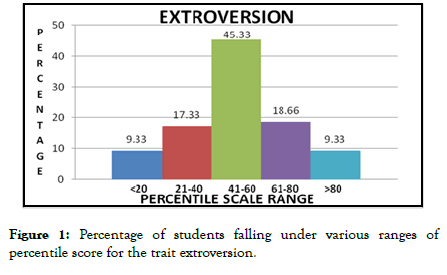
Figure 1: Percentage of students falling under various ranges of percentile score for the trait extroversion.
Emotional stability
The emotional stability of the participants seemed to be very low which is evident from the scores that 36% of them fall under the percentile score of below 20%. In addition, 26.66% of them seemed to be somewhat unstable in their emotions. On a whole, nearly 66% of the participants were emotionally unstable and not aware of how to handle the situation and decide depending upon the happening around them. Only 9.33% of them seemed to be stable in controlling their emotions and they think logically to handle at a given particular situation. Contrary to the other traits, it seems that the participants are highly stable in their emotions, rigid in their ideas and opinions when it comes to the matter of decision making or listening to others opinion (Figure 2). The important trait of an individual in adapting themselves in to a given particular academic activity is this Emotional stability which should be flexible and the person should be understandable by others and should understand others opinions too. From the scores earned by the participants, it seemed that higher percentages of them fall under either rigid or somewhat rigid character and few of them fall under neutral character. Only very less percentage of participants seemed to be flexible and stable in their emotions.
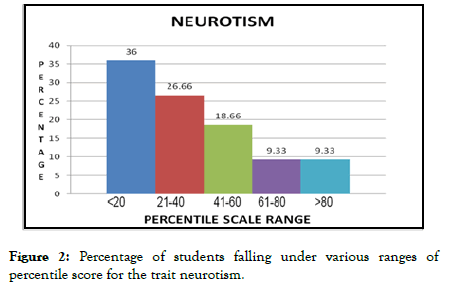
Figure 2: Percentage of students falling under various ranges of percentile score for the trait neurotism.
Agreeableness
According to the percentile scores earned by the participants, it seems that nearly 52% of the individual were not warm, friendly, and tactful. This is said to be the agreeableness. They seemed to have pessimistic view of the things around them. They seemed to be very poor in getting along with others. They keep arguing for each issue during discussion. On a whole they seemed to be a controversial person. It is very pathetic to see, only 1% of the participants were seemed to be cordial and agreeing with others opinion. They seemed to have a character of get along with the crowd and listen to the opposite person patiently. Nearly 24% of the participants seemed to be somewhat agreeing with others and remain non-controversial. Overall, 25% of the participants are found to be optimistic and co-operative. This is said to be main character needed for a future doctor who has to remain calm and listen to the patients, peers and superiors very carefully to make an appropriate judgment in a diagnosis (Figure 3).
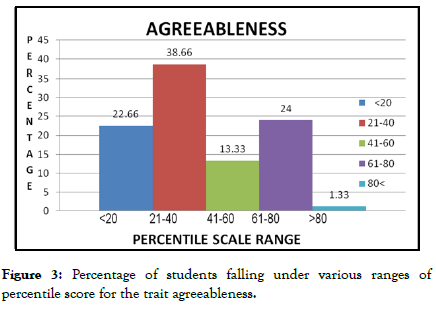
Figure 3: Percentage of students falling under various ranges of percentile score for the trait agreeableness.
Conscientiousness
Nearly 12% of the participants have responded in such a way that they seemed to be highly non-diligent and careless person. They seemed to be doing things in a dis-organized way and lacking self-discipline. They are not duty conscious and not at all aiming at achievement. They often found to be not systematic. Nearly 33.33% of the participants also found to be falling under this category. As a whole, nearly 44.33% of the participants were found to be non-diligent and somewhat non-diligent and careless. Based on the scores earned by the participants about 10-16% of them only were seemed to have carefulness in their duty. They seemed to possess a desire to carry out a task well and in a planned manner. They seemed to have a trait of doing the things efficiently and diligently. They seemed to plan a work assigned to them in a proper and in a planned manner. They seemed to possess the trait of doing the things in a perfect and oriented way. They are highly reliable and dependable for any task. This is an important trait, which one should possess while dealing trauma cases (Figure 4).
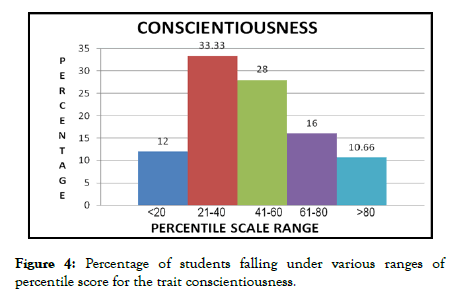
Figure 4: Percentage of students falling under various ranges of percentile score for the trait conscientiousness.
Intellect/Imagination
Finally, the intellect of the participants seemed to be very high only in 1.33% of the individuals and 6.66% were intellect and somewhat intellect. Only 7.99% of the individuals seemed to be intellect and open-minded person. They seemed to analyze and evaluate the things in an effective way and goal towards academic accomplishments. They seemed to possess abstracting the things from the happenings and react logically. The highest group falls under highly ignorant and close-mindedness which seemed to be about 61.33%. About 21.33% seemed to be somewhat ignorant and dogmatic. They never reason out and never see the things objectively. They seemed to be poor in abstracting the things and matters around them (Figure 5).
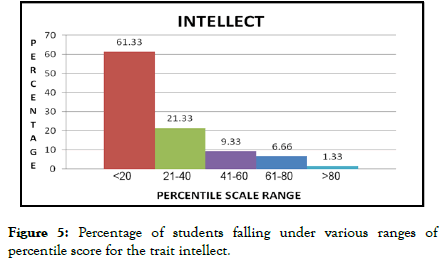
Figure 5: Percentage of students falling under various ranges of percentile score for the trait intellect.
From the overall percentile scores earned by the participants, it is evident that the highest percentage of the people falls under introversion, emotional stability, non-cooperative, carelessness and highly dogmatic and close-minded one. On the other hand, the least percentage of participants falls under the category of extrovert, emotionally unstable, cooperative, carefulness, open-mindedness.
All the above observations remain as an evident that the students who are in the first year of medical course seemed to have less affinity towards academic performance and need more attention. According to the overall percentile scores earned by the participants, excepting the emotional stability all participants fall under unacceptable personality traits, which seemed to be ranging within 26.66% to 82.66% where the highest non-acceptable trait seemed to be the intellect of the person. On the other hand, the acceptable personality traits were ranging between only 7.99%-27.99% of which the extroverted characters only seemed to have the highest percentage. Regarding emotional stability, as the reading of the percentile scores are to be interpreted in the reverse direction, the higher the score, the higher is the nature of the person who remain stable and non-flexible as well as rigid contrary to the character of being flexible and fragile and not stable in emotions and who can adjust with the situation and know to control the emotions according to the situation. This is well noticed from the scores that the highest score (above 80%) was earned by 9% of the participants whereas the lowest score (below 20%) was earned by nearly 36% of the participants (Figure 6).
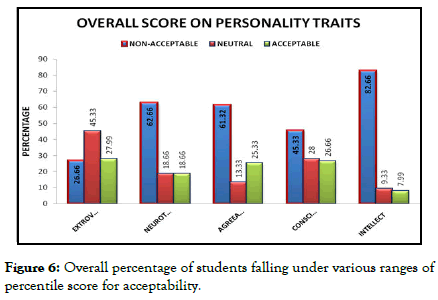
Figure 6: Overall percentage of students falling under various ranges of percentile score for acceptability.
From the results obtained in the present study, it is very much evident that the students who enter the medical course, most of them do not seemed to possess the basic five traits to accomplish the expected curricular outcome as a Basic Medical Graduate at the end of the course to serve the society with the medical needs in the health care sector. According the scores obtained, they were characterized as individuals possessing acceptable and non-acceptable characters and neutral. The highest percentages of the participants are falling under either non-acceptable character or neutral category. Only very less percentage of people only falls under acceptable character category. This shows that the students who join the medical course are not stable in their psychology and not possessing the basic five factors of the personality traits, which are the deciding factors of the academic performance of the individual. This is because the in student life, they have been trained for years together to memorize the contents of the subjects and to reproduce exactly what is given in the book. There was no opportunity for analytical or critical thinking. Exactly opposite is the professional course of study. In medical profession, one is expected to possess a character to perform five five roles in the society as Clinician, Leader, Communicator, Life-long learner and a Researcher. For all these roles, which are the evidences for their academic excellence, there are five personality traits needed at the basic level to explore their academic performance [10-13].
From the study, it is proved that there is an utmost need for counselling and screening of students in a proper and a systematic way and to categorize the students according to their traits. This has to be maintained confidentially and further counselling sessions shall be arranged to rule out the non-acceptable characters and to convert those candidates into acceptable characters. This would help them to develop their personality traits fitting them in the next 5 ½ years of course to accomplish the five roles of an Indian Medical Graduate according to the act.
To fulfil the goals of IMG Act, 2012 to produce a medical graduate to act in fives roles of a doctor, the five basic personality traits need to be screened at the entry level of a medical course. Then only the students shall be molded in the next 5 ½ years to accomplish the five roles of an Indian Medical Graduate.
I thank Dr. Arumuganathan, Assistant Professor, Department of Psychiatry for his earnest support and guidance in this project. I thank the management for given me permission to conduct the project in a successful manner.
Citation: Sivakumar G (2018) Screening of Basic Personality Traits of First Year Medical Students at Entry Level to Assess their Academic Acquaintance in an Indian Medical School. J Psychol Psychother 9:356. doi: 10.35248/2161-0487.19.9.356
Received: 17-Mar-2019 Accepted: 22-Apr-2019 Published: 30-Apr-2019 , DOI: 10.35248/2161-0487.19.9.356
Copyright: © 2019 Sivakumar G. This is an open access article distributed under the terms of the Creative Commons Attribution License, which permits unrestricted use, distribution, and reproduction in any medium, provided the original work is properly cited.